Ijraset Journal For Research in Applied Science and Engineering Technology
- Home / Ijraset
- On This Page
- Abstract
- Introduction
- Conclusion
- References
- Copyright
Comparative Analysis Between Different Antistripping Agents Used in Hot Mix Asphalt
Authors: Burhan Rashid, Dr. Hemant Sood, Dr. Ankit Kathuria
DOI Link: https://doi.org/10.22214/ijraset.2022.44713
Certificate: View Certificate
Abstract
In current study, an attempt has been made to investigate the different anti-stripping agents (Zycotherm (0.08%, 0.10%, 0.12%) and Wetbond-S (0.06, 0.08%, 0.10%)) in hot mix asphalt (HMA) to curb the problem of stripping and moisture susceptibility in the aggregates. For this, different laboratory tests such as boil test, stripping value test, Marshall Stability test, and retained stability test were conducted and respective results were collected. From the results, it can be concluded that the utilization of the anti-stripping agents (Zycotherm-0.12% or Wetbond-S-0.08%) to make the raw aggregates stripping proof can be done.
Introduction
I. INTRODUCTION
Being advantageous (better riding experience, less construction time, and easy repairs) over other types of pavements, bituminous pavements are preferred. These types of pavements, no doubts have disadvantages too as they are affected by weather conditions, traffic loads, and counts that result in various forms of pavement defects like cracking, stripping, rutting, etc. These pavement defects ultimately affect the service life of the pavement and end up reducing it. Numerous repairs have been done on pavements due to occurring of such defects and even, in extreme damage, the roads are replaced due to the loss of adhesion between the binder and aggregates. Due to the weakening of the bond, functional weakness of the pavement occurs which require huge money for its repairs.
One of the essential characteristics of good performance of asphaltic pavement is the better bond between the bitumen and aggregate. The bond between these materials is a crucial standard that defines the grade of asphalt mixture, its performance, and resistance to distress/moisture. The absence of proper bonding can guide the occurrence of various damages to the asphalt pavement. To determine the sticking properties between bitumen and aggregates, that are to be used in road infrastructure, different tests were introduced and are practiced. The bonding behaviour is impacted by the attributes of both the materials i.e. bitumen and the aggregate used in the asphalt blend. Adhesion can be commonly described as the molecular force of attraction between two entities of a different character when they come in contact with each other.
Since primitive times, bitumen is being used for various purposes. The bitumen acts as a binder that holds the aggregates in a road pavement which becomes a hard mass. The hard bond between bitumen and aggregates is indispensable and should be impeccable and should not break under any condition. The strength of the bond depends upon the amount of bitumen, grade of bitumen, and type of aggregates that were used for the asphalt mixture. The breaking of the bond between bitumen and aggregates in the pavement surface is called stripping. This phenomenon occurs when the water percolates into the bitumen and aggregate voids. As the surface of aggregates has more attraction towards water than bitumen, the adhesion is broken/weakens. This type of phenomenon can be seen commonly on Indian bituminous roads. The drainage conditions and surface moisture content are the primary factors that contribute to the analysis of stripping. Poor drainage and more surface moisture can easily trigger the stripping process in the bituminous pavement.
II. ANTI-STRIPPING AGENTS
To alleviate the stripping problem in flexible pavements and to curb the cost of maintenance, different anti-stripping agents like Zycotherm [4], Wetmul, Wetbond-S, Bitugrip, etc. are being used. However, in India, these agents are being used only for important pavements such as Airport pavements, Defence Roads etc. Zycotherm and Wetbond-S, anti-stripping agents, are popular and have different physical and chemical properties. These agents are discussed as under:
- ZYCOTHERM: It is a next-generation anti-stripping agent with the extra advantage of warm-mix asphalt (WMA). It has high compatibility with all forms of aggregate that helps in enhancing the adhesion between bitumen and aggregate at a very low dosage. It allows temperature reduction during the production of the bituminous mix. The other beneficial parameters of this product are better Chemical Bonding, Complete Coating, and thorough Compaction. Unlike primitive anti-stripping agents, that form a frail physical sealant between the aggregates and binder, Zycotherm creates a permanent bond chemically between the aggregate and the binder. With the help of this permanent bond formed chemically, the moisture resistance and durability of the pavement significantly increases and overall cost reduces. As this works with any type of aggregates, this can be used anywhere while keeping its dosage to the minimum. It is an eco-friendly agent that is odour-free and non-corrosive in nature. The bitumen mixed with Zycotherm creates a coating over the surface of aggregates quickly and without any problem than the conventional type of anti-stripping agents. The even coating of every single aggregate and wetting attribute ensures good mixing and a jet black colour on the surface.
- WETBOND-S: It is also a next-gen nano-technology Silicon-based anti-stripping agent that can be used for Asphalt. This can be used with a low dose and is extremely resistant to thermal which can be used for Hot-mix and Warm-mix road constructions. The aggregates for which controlling stripping profile is hard and tough, this product can be very useful.
III. RESEARCH METHODLOGY
In order to achieve the goal of the current research study, the hot mix asphalt and the raw aggregates were evaluated for their stripping values through different laboratory tests. For this, the properties and characteristics of various materials such as raw aggregates, binders, and anti-stripping agents were determined. The steps that were involved in the current research methodology are described as under:
- Raw aggregates and bitumen of PMB-40E was collected from Ujh quarry near Kathua J&K and Hincol Industries respectively. The laboratory tests on aggregates and bitumen was carried out
- The stripping values of raw aggregates were then determined from stripping value test and boil test in the laboratory.
- As per MORTH, the mix design for bituminous grade-I was prepared and from different mixes entailing different bitumen content and Marshall Stability test, optimum bitumen content was found out.
- Utilization of anti-stripping agents (zycotherm and wetbond-S) was done at this stage to reduce the stripping effect on aggregates.
To assess the effect of anti-stripping agents on aggregates, Retained Marshall Stability test was also performed and % retained coating was determined.
IV. RESULTS
The result of various laboratory tests are represented in tabular and graphical form while interpreting them to draw the final conclusion of the current study. The results are represented in the following sections.
A. Results Of Boil Test And Stripping Value Test Of Raw Aggregates
Table: 1. Results of Boil Test and Stripping Value Test.
|
S. No. |
Test |
Retained Coating |
Permissible Limit |
Remarks |
|
1 |
Stripping value Test |
91% |
95% |
Susceptible to Stripping |
|
2 |
Boil Test (30 minutes) |
85% |
95% |
Susceptible to Stripping |
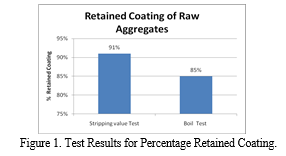
From the above table, it was observed that the raw aggregates are prone to stripping and will create defects in the road pavement. Therefore, anti-stripping additives were needed so that the stripping phenomenon can be controlled and the results be obtained within permissible results.
B. Test Results Of Marshall Stability Test
As per the final gradation, the ratio of blend (20mm : 10mm : Stone Dust : Cement) comes out to be (32:19:47:2). The final quantity of various aggregates was 384 gms of 20mm aggregates, 288 gms of 10 mm aggregates, 564 gms of stone dust and 24 gms of cement. For the marshal stability Test, a total of 5 different proportions of bitumen binder were selected i.e. 5.00%, 5.25%, 5.50%, 5.75%, and 6.00%. After making all the samples, these were then tested on the Marshall Stability apparatus, and stability and flow values were recorded.The results so obtained are represented here under in Table 2.
Table: 2. Results of Marshall Stability Test.
|
Results / Bitumen Content |
5.00% |
5.25% |
5.50% |
5.75% |
6.00% |
|
Specific Gravity of Bitumen |
1.02 |
1.02 |
1.02 |
1.02 |
1.02 |
|
Theoretical Sp. Gravity (Gmm) |
2.46 |
2.45 |
2.44 |
2.43 |
2.42 |
|
Bulk Sp. Gravity (Gmb) |
2.31 |
2.33 |
2.36 |
2.37 |
2.36 |
|
Air Voids, % |
6.07 |
4.89 |
3.30 |
2.54 |
2.59 |
|
Void's in Mineral aggregate (VMA) % |
17.36 |
16.87 |
16.03 |
15.90 |
16.47 |
|
Void filled with bitumen (VFB) % |
65.06 |
70.99 |
79.39 |
84.04 |
84.27 |
|
Marshall Stability |
21.60 |
23.62 |
28.32 |
24.67 |
22.85 |
|
Flow Value |
3.58 |
3.64 |
3.97 |
4.02 |
4.43 |
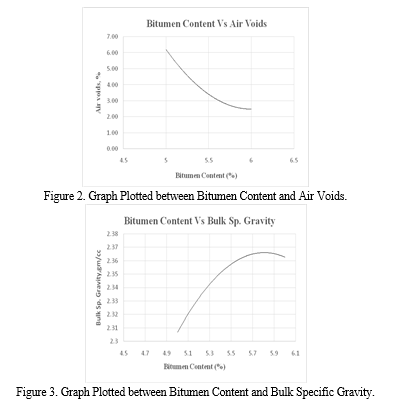
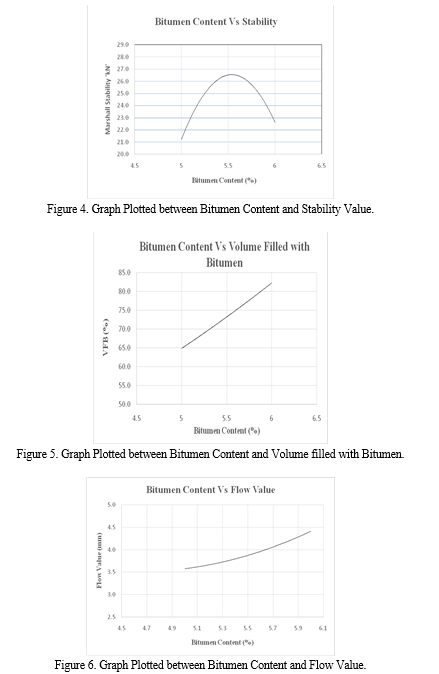
After conducting the Marshall Stability test in the laboratory and scrutinizing the results, the optimum dosage (%) of bitumen binder was calculated. The optimum bitumen content was taken as the average of the 3 values: binder content at the maximum value of Marshall Stability, maximum bulk specific gravity and 4% air voids and it comes out to be 5.56%. Therefore, the final parameters for bituminous concrete of grade-I is mentioned below.
Table: 3. Design Parameters of Bituminous Concrete Grade-I
|
Parameter |
Test Results |
As per MORTH Specifications |
|
Bitumen Content by weight of total mix (%) |
5.56 |
5.2% Min. |
|
Marshall Stability (KN at 60?) |
26.5 |
12KN Min. |
|
Marshall Flow Value (mm) |
3.91 |
2.5-4 |
|
Air Voids (%) |
3.10 |
3-5 |
|
Voids filled with bitumen (VFB, %) |
73.8 |
65-75 |
|
Laboratory Density of the Mix (gm/cc) |
2.36 |
- |
C. Results Of Boil Test And Stripping Value Test Using Anti-Stripping Agents
The various specimens having different proportions of anti-stripping agents (Zycotherm and Wetbond-S) by weight of bitumen were prepared for boil test (as per the IS 14982:2017) on and the results recorded are shown in the Table 4 & 5 below:
Table: 4. Boil Test Results for Optimum Dosage of Anti-Stripping Agents.
|
Zycotherm % |
Minimum % retained Coating |
Wetbond-S % |
Minimum % retained Coating |
|
0.08 |
90% |
0.06 |
90% |
|
0.10 |
93% |
0.08 |
97% |
|
0.12 |
96% |
0.10 |
95% |
Table: 5. Test Results for Boil test and Stripping Value test.
|
S.no. |
Specimen |
Boil test (% retained coating) |
Stripping value test (% retained coating) |
|
1 |
No anti-Stripping agent |
85 |
91 |
|
2 |
With 0.12% Zycotherm |
96 |
99 |
|
3 |
With 0.08% Wetbond-S |
97 |
99 |
After scrutinizing the results of boil test when the specimens are mixed with different proportions of zycotherm and Wetbond-S, the optimum dose of these anti-stripping agents were found out and it comes out to be 0.12% by the weight of bitumen for Zycotherm which has 96% retained coating and 0.08% by the weight of bitumen for Wetbond-S which has 97% retained coating and this fulfils the minimum codal requirement. Then, at these optimum percent of zycotherm (0.12%) and Wetbond-S (0.08%), Stripping value test was conducted and the stripping values for zycotherm and Wetbond-S come out to be 99%.
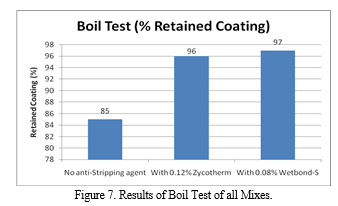
D. Results Of Retained Marshall Stability Test
After obtaining the optimum dosage of various anti-stripping agents, retained Marshall Stability Test was carried out in order to check the moisture susceptibility for the bituminous mix at optimum bitumen content 5.56%. For this purpose, unconditioned stability value and conditioned stability value were determined for raw mix, mix containing zycotherm and mix containing wetbond-S and represented in Table 6 & 7 given below:
Table: 6. Test results for Retained Marshall Stability for Raw Mix.
|
S.no. |
Type of Sample |
Stability Value (kN) |
Average Stability Value (kN) |
||
|
1 |
Unconditioned Sample |
23.2 |
25.5 |
21.1 |
23.9 |
|
2 |
Conditioned Sample |
19.4 |
20.5 |
19.5 |
19.8 |
Therefore, Retained Stability = (19.8 /23.9) ×100 = 82.9%
Table: 7. Test results for Retained Marshall Stability for Mix containing 0.12% Zycotherm.
|
S.no. |
Type of Sample |
Stability Value (kN) |
Average Stability Value (kN) |
||
|
1 |
Unconditioned Sample |
25.2 |
26.5 |
27.3 |
26.3 |
|
2 |
Conditioned Sample |
24.6 |
23.5 |
24.9 |
24.3 |
Therefore, Retained Stability = (24.3 /26.3) ×100 = 92.4%
Table: 8. Test results for Retained Marshall Stability for Mix containing 0.08% Wetbond-S.
|
S.no. |
Type of Sample |
Stability Value (kN) |
Average Stability Value (kN) |
||
|
1 |
Unconditioned Sample |
27.5 |
24.8 |
25.9 |
26.0 |
|
2 |
Conditioned Sample |
24.9 |
21.7 |
22.3 |
22.9 |
Therefore, Retained Stability = (22.9 /26) ×100 = 88.1%
From the above results, it was concluded that the Marshall Stability of the specimen was improved by 10% when Zycotherm anti-stripping agent was used and 9% when Wetbond-S anti-stripping agent was used. Moreover, the Retained Stability was also improved by 11.5% and 6.3% when Zycotherm and Wetbond-S anti-stripping agent was used respectively (refer fig. 8). Therefore, both the anti-stripping agents are efficient.
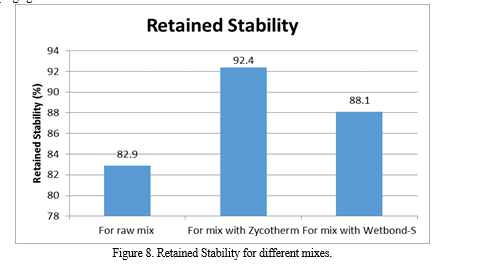
Conclusion
In current study, the performance of anti-stripping agents were evaluated for bituminous concrete grade-I. From the various laboratory test results, following conclusions were drawn for current experimental study: 1) The raw aggregates were prone to stripping process as the percentage retained coating from stripping value test and boil test comes out to be 91% and 85% respectively. 2) The optimum Content of the bitumen was 5.56. At optimum bitumen content, Marshal Stability value, Marshall Flow value, % air voids, % Voids filled with bitumen was found out to be 25.6 kN, 3.91 mm, 3.10% and 73.8% respectively. 3) After adding anti-stripping agents to the aggregates, 0.12% of Zycotherm and 0.08% of Wetbond-S becomes the Optimum dosage for the mix as per the results of boil test. Therefore, it was concluded that the percentage increase in the retained coating is 12.95 % and 14.12% when Zycotherm and Wetbond-S is used respectively for boil test. Whereas, from stripping value test results, it has been concluded that for both the agents, i.e. Zycotherm and Wetbond-S, the percentage increase in the retained coating is 8.80%. 4) From the Retained Marshall Stability Test, it was concluded that the Marshall Stability of the specimen was improved by 10% when Zycotherm agent was used and 9% when Wetbond-S agent was used. Moreover, the Retained Stability was also improved by 11.5% and 6.3% when Zycotherm and Wetbond-S anti-stripping agent was used respectively. However, Anti-stripping agent Zycotherm is more efficient than Wetbond-S. Therefore, to finally conclude the results in the gist, it is suggested to utilize the anti-stripping agents (Zycotherm-0.12% or Wetbond-S-0.08%) to make the raw aggregates stripping proof.
References
[1] T. B. Vishnu & Kh. Lakshman Singh, \"A study on the suitability of solid waste materials in pavement construction: A review,\" International Journal of Pavement Research and Technology , vol. 14, p. 625–637, Dec. 2020. [2] Cesare Oliviero Rossi ,Bagdat Teltayev and Ruggero Angelico , \"Adhesion Promoters in Bituminous Road Materials: A Review,\" Applied Science, vol. 7, no. 5, pp. 524(1-10), 2017. [3] Surajo Abubakar Wada, \"Bituminous Pavement Failures,\" Journal of Engineering Research and Applications, vol. 6, no. 2, pp. 94-100, February 2016. [4] Dr. Maninder Singh, Dr. Kunal Jain, Sukhjinder Singh Kahlon, \"A Literature Review on the Role of Zycotherm as an Additive used in Bitumen,\" International Journal of Trend in Scientific Research and Development (IJTSRD), vol. 4, no. 6, pp. 1354-1360, September-October 2020. [5] Mahmoud Ameri, Hassan Ziari, Afshar Yousefi, and Ali Behnood, \"Moisture Susceptibility of Asphalt Mixtures: Thermodynamic Evaluation of the Effects of Antistripping Additives,\" Journal of Materials in Civil Engineering, vol. 33, no. 2, p. 04020457, February 2021. [6] Masoud Faramarzi, Behnam Golestani and K.Wayne Lee, \"mproving moisture sensitivity and mechanical properties of sulfur extended asphalt mixture by nano-antistripping agent,\" Construction and Building Materials, vol. 133, pp. 534-542, 2017. [7] Arpita Saha, Bhuperndra Singh and Subhadip Biswas, \"Effect of nano-materials on asphalt concriete mixes; Acase study,\" European Transport\\Trasporti Europei, no. 65, pp. 1-12, July 2017. [8] Dae-Wook Park, Woo-Jin Seo, Jun Kim , and Hai Viet Vo, \"Evaluation of moisture susceptibility of asphalt mixture using liquid anti-stripping agents,\" Construction and Building Materials, vol. 144, pp.399-405, July 2017. [9] Harpreet Singh, Tanuj Chopra , Neena Garg and Maninder Singh, \"Effect of zycotherm performance of neat bitumen and bituminous concrete mixes,\" hInternational Journal of Civil Engineering and Technology (IJCIET), vol. 8, no. 8, pp. 232-238, August 2017. [10] Hamed Omrani, Ali Reza Ghanizadeh and Amin Tanakizadeh, \"Effect of SBS Polymer and Antistripping Agents on the Moisture Susceptibility of Hot and Warm Mix Asphalt Mixtures,\" Civil Engineering Journal, vol. 3, no. 10, pp. 987-996, November 2017. [11] H.Khani Sanij,P.Afkhamy Meybodi,M.Amiri Hormozaky,S.H.Hosseini, and M.Olazard, \"Evaluation of performance and moisture sensitivity of glass-containing warm mix asphalt modified with zycotherm TM as an anti-stripping additive,\" Construction and Building Materials, vol. 197, pp. 185-194, February 2019. [12] Kunal kuamr Vaghela, Asso. Prof. V.J. Chitaria, Dr. Prakash Mehta, \" Evaluation of organosilane based asphalt additive for flexible pavement,\" International Research Journal of Engineering and Technology (IRJET), vol. 5, no. 2, pp. 1194-1197, Feb-2018. [13] Shazi , babu banarsi das university; D. S. Ray, BBDNITM, \"Study and Evaluation of Disintegration of Pavement Surface,\" International Journal for Scientific Reserach and Development(IJSRD), vol. 6, no. 3, pp. 486-488, June 2018. [14] Peyman Mirzababaei, Fereidoon Moghadas Nejad, and Koorosh Naderi, \"Effect of liquid silane-based anti-stripping additives on rheological properties of asphalt binder and hot mix asphalt moisture sensitivity,\" Road Materials and Pavement Design, vol. 21, no. 2, pp. 570-585, August 2020. [15] Purnima Tripathi, D. S. Ray, \"Optimization of Different Anti Stripping Agents in Construction of Flexible Pavement,\" International Journal Of Engineering Research & Technology (IJERT), vol. 9, no. 7, July 2020.
Copyright
Copyright © 2022 Burhan Rashid, Dr. Hemant Sood, Dr. Ankit Kathuria. This is an open access article distributed under the Creative Commons Attribution License, which permits unrestricted use, distribution, and reproduction in any medium, provided the original work is properly cited.

Download Paper
Paper Id : IJRASET44713
Publish Date : 2022-06-22
ISSN : 2321-9653
Publisher Name : IJRASET
DOI Link : Click Here
 Submit Paper Online
Submit Paper Online

